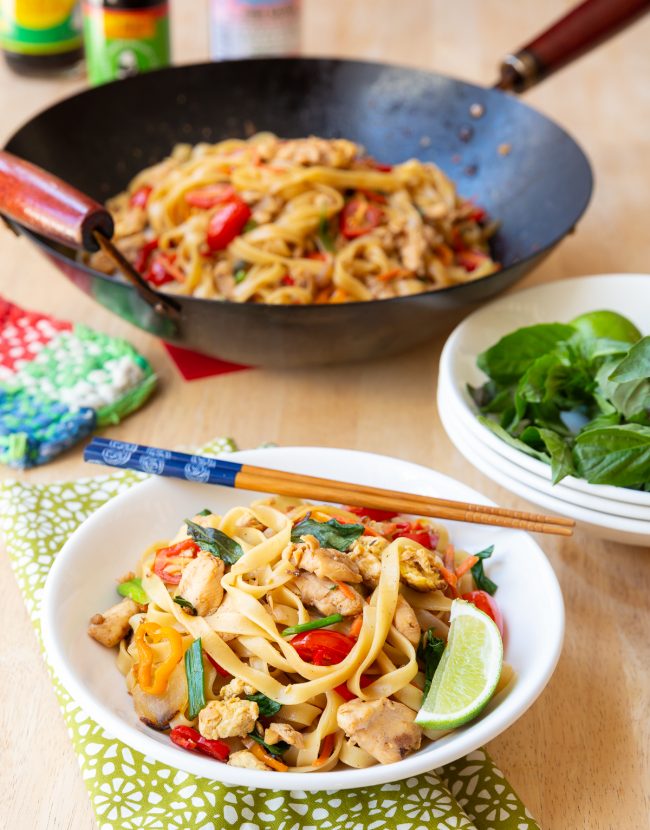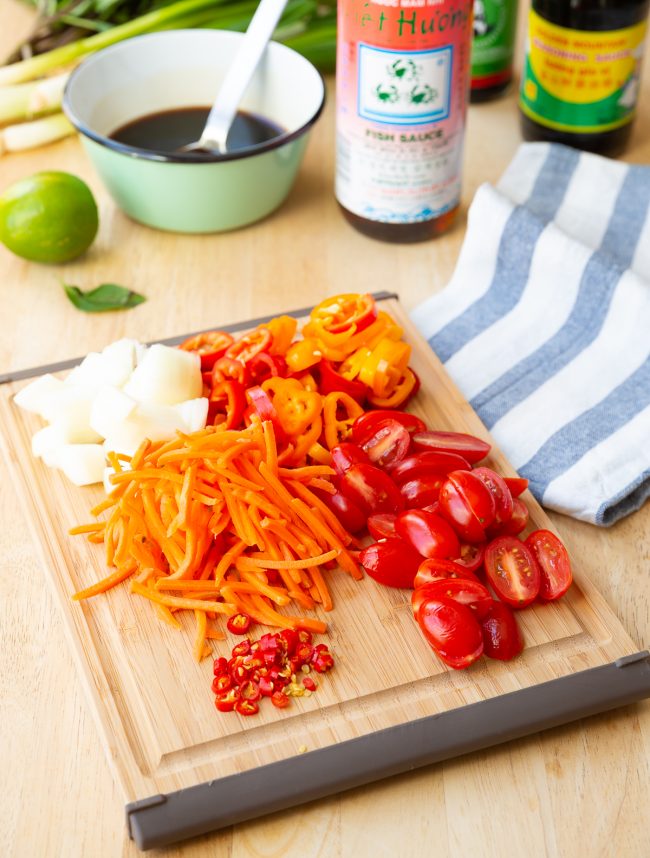Why We Love This Pad Kee Mao AKA Thai Drunken Noodles Recipe
When you sit down in a Thai restaurant here in the states, there are a few dishes you will nearly always find on the menu: Pad Thai, Thai Fried Rice, Red Curry, and Pad Kee Mao, also known as Drunken Noodles. However, Drunken Noodles are a tasty example of Asian “fusion food” in its truest form. After Chinese immigrants crossed the borders in surrounding countries, this dish became popular in Thailand and started selling the common street-food dish, Phat Si Ew, made with wide noodles. The biggest difference between Phat Si Ew and Pad Kee Mao is that the Thai people added spicy peppers and sweet Thai basil over time. A brilliantly fragrant addition, in my opinion. So where did the “drunken” part of the Drunken Noodles name come from? There are many different stories of how these noodles became known as Drunken Noodles because there is no alcohol in the recipe. One theory is that they are so spicy, those partaking get drunk in the process of trying to quench their thirst. Of course, you can adjust the heat to your liking; no need to worry about sending dinner guests home in a state of inebriation. Another theory is that these Thai noodles should be eaten with a cold beer and make a great hangover cure!
Ingredients You Need
For the Sauce:
Oyster sauce – a slightly sweet and salty sauce that is thickened with cornstarch Fish sauce – a fermented, salty sauce that is an essential element in East Asian cuisine Fresh lime juice – provides the acid necessary to create a perfectly blended Drunken Noodles sauce Maggi sauce – or Golden Mountain sauce, for a strong salty flavor Brown sugar – to add just a bit of sweetness for balance
The oyster sauce, fish sauce, and Maggi Sauce can all be found in most mainstream grocery stores and at all Asian grocery stores. Maggi Sauce (or Golden Mountain) is a heavily seasoned soy-based sauce which is similar to dark soy sauce. All of these ingredients are salty, so you will not need to salt this dish at any point. For the Drunken Noodles:
Wide rice noodles – Pad Kee Mao is traditionally made with wide fresh rice noodles, however, if you can’t find them, use wide egg noodles. Chicken breast – thinly sliced for quick cooking in the wok Eggs – lightly beaten Onion – peeled and chopped Garlic cloves – finely minced Thai chilis – use red chilis or jalapeños, seeded and sliced thin Carrots – shredded Red bell pepper – or any color peppers you like, seeded and thinly sliced Grape tomatoes – halved Thai basil leaves – sweet and fragrant for balancing the spiciness of the peppers. You can use Thai holy basil or regular Thai basil. Green onion – use just the tops, cut into approximately 1-inch pieces Coconut oil – for cooking in the wok or large skillet Lime wedges – to garnish
How to Make Thai Drunken Noodles
Start by mixing all of the listed sauce ingredients to create the Pad Kee Mao sauce. Set aside. Boil water and cook noodles according to package instructions. Next, heat a wok or large pan to high heat and add a touch of coconut oil along with the beaten eggs. Cook the eggs until set, then push up the side to slow the cooking. Then sauté the garlic, onions, and Thai chiles in the wok. If needed add another small amount of oil, and then the sliced chicken breasts. Once cooked, push the mixture up the side and quickly stir fry the veggies. I used bell peppers and carrots (and added tomatoes later) but you could also add snow peas, broccoli, or baby corn. Once the veggies are just barely cooked (but still firm) add in the drained noodles and the sauce. Toss and mix with fresh green onions, Thai basil leaves, and tomatoes. It’s that easy!
Get the Complete (Printable) Pad Kee Mao Recipe Thai Drunken Noodles Below. Enjoy!
Tips & Tricks
Add extra veggies! You can go crazy with the veggies here by adding things like bok choy, broccolini or regular broccoli florets. Prep ingredients before cooking! Have all your ingredients prepped and ready before you start cooking. This includes slicing the meat, chopping the vegetables, and mixing the sauce. Stir-frying happens quickly, so it’s important to have everything ready to go. Don’t skip the Thai basil! Thai basil adds a distinctive flavor to Pad Kee Mao. Stir it in at the end of cooking to preserve its fresh, aromatic qualities. If you can’t find Thai basil, use regular basil as a substitute, but note the flavor will be slightly different.
Is it Possible to Cook Pad Kee Mao Without a Wok?
While a wok really is the best cooking instrument for this recipe, you definitely can use a large skillet to make this Drunken Noodles recipe. You can always set some of the cooked ingredients aside as you sauté different ingredients to save room and get an even cook. Then combine everything together when the noodles are ready to be added.
How Can I Make Vegetarian Drunken Noodles?
Substitute extra firm tofu or your favorite hearty veggies – like mushrooms or squash – in place of the chicken breasts to make this a healthy vegetarian Pad Kee Mao recipe.
Is Pad Kee Mao Gluten-Free?
It can be! Carefully read the ingredients listed on the sauces to ensure there are no wheat-based fillers: most use gluten-free corn starch but you definitely want to double-check. The rice noodles traditionally used in this recipe are also gluten-free!
How Long Can This Dish Be Stored?
If kept in an airtight container in the refrigerator, Drunken Noodles will stay good for 3-4 days. Rice noodles do not freeze well, so I don’t recommend keeping leftovers in the freezer.
Is There a Difference in Thai Basil and Regular Basil?
Thai basil and regular “sweet basil” so have a slightly different flavor. Thai basil has an added aniseed flavor on top of the basil flavor, which is perfect for this recipe. If you cannot find Thai basil, using sweet basil would be the perfect substitution.
Are There Other Pad Kee Mao Variations?
Yes, there are! You can change up the protein that you add to the noodles with pork, beef, shrimp, or tofu. You can make it a spicier recipe with added chili sauce, or you can chop up some Thai Bird Chili’s and sprinkle them on the top.
Looking for More Asian-Inspired Recipes? Be Sure to Also Try:
Paleo Cauliflower Fried Rice Korean Veggie Pancakes Vegetable Lo Mein Skinny Orange Chicken – Add A Pinch Salmon Sesame Soba Noodles – Half Baked Harvest Crispy Beef – Table for Two Blog
Share This Recipe With Friends!





